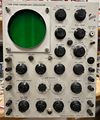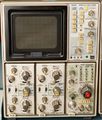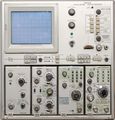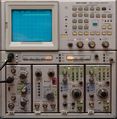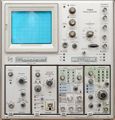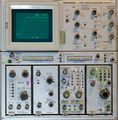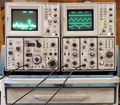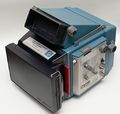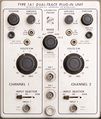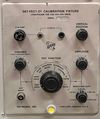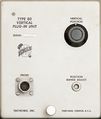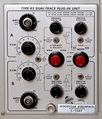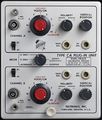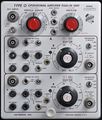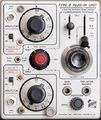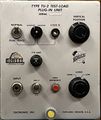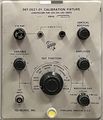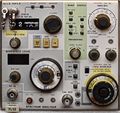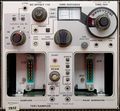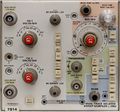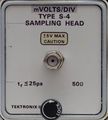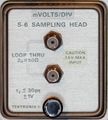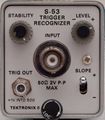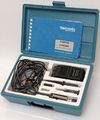User:Peter: Difference between revisions
No edit summary |
No edit summary |
||
| Line 5: | Line 5: | ||
For budget reasons, the first scope I bought for myself was a rather pedestrian circa-1986 Hitachi 100 MHz 2-ch portable (a la [[465]]). | For budget reasons, the first scope I bought for myself was a rather pedestrian circa-1986 Hitachi 100 MHz 2-ch portable (a la [[465]]). | ||
It did pay for itself through a consulting assignment (2nd generation products of this effort are still in service), | It did pay for itself through a consulting assignment (2nd generation products of this effort are still in service), | ||
but I learned only some time later what the difference between a ''passable'' scope like that and a '' | but I learned only some time later what the difference between a ''passable'' scope like that and a ''good'' scope was, when I compared them side by side in overdrive ... | ||
The first Tek scope in my own possession was the [[7613]] pictured below, which I bought in early 2014. | The first Tek scope in my own possession was the [[7613]] pictured below, which I bought in early 2014. | ||
Looking for manuals (its power supply needed some TLC), I found TekWiki. | Looking for manuals (its power supply needed some TLC), I found TekWiki. | ||
The resurrected 7613 did not remain alone for long – see below for the current inhabitants of ''Tek Sanctuary Central Europe''. | The resurrected 7613 did not remain alone for long. | ||
I worked my way up from ''good'' scopes to ''extraordinary'' ones – see below for the current inhabitants of ''Tek Sanctuary Central Europe''. | |||
On this Wiki, [[User:Kurt|Kurt]] created an account for me in May 2014. I started to add a few photos and some data, then began building categories and some templates. | On this Wiki, [[User:Kurt|Kurt]] created an account for me in May 2014. I started to add a few photos and some data, then began building categories and some templates. | ||
Revision as of 11:31, 5 October 2023
Hi, my name is Peter (who would have guessed?). I was born and live in Austria. Originally an EE, my current day job is in IT, in an international environment.
The first Tek I worked with – around 1982 IIRC – was a T912 "vacuum cleaner" which I must say left me slightly underimpressed compared with my favourites at the time, the HP 1740 series.
For budget reasons, the first scope I bought for myself was a rather pedestrian circa-1986 Hitachi 100 MHz 2-ch portable (a la 465). It did pay for itself through a consulting assignment (2nd generation products of this effort are still in service), but I learned only some time later what the difference between a passable scope like that and a good scope was, when I compared them side by side in overdrive ...
The first Tek scope in my own possession was the 7613 pictured below, which I bought in early 2014. Looking for manuals (its power supply needed some TLC), I found TekWiki. The resurrected 7613 did not remain alone for long. I worked my way up from good scopes to extraordinary ones – see below for the current inhabitants of Tek Sanctuary Central Europe.
On this Wiki, Kurt created an account for me in May 2014. I started to add a few photos and some data, then began building categories and some templates.
In June of that year, Kurt already gave me admin rights, thanks for the trust! One thing led to another ... having been familiar with Mediawiki (I set up a corporate Intranet with that software in 2006 that is still in use), I started getting involved in this site's software side as well, and over the years helped expand its coverage a bit.
Feel free to contact me if you have questions about the Cargo database module, for example.
You can also find me as Peter7000 over at Wellenkino.
Cheers
- --Peter
Scopes
-
465 − from the estate of a hobbyist
-
502 − spent many years in a university lab attached to strain gages watching metal samples being broken, at the end reduced to be a DSO pre-amp
-
511AD − from a physics institute in Slovenia
-
545A − from a guy with a remarkable collection of early radios and phonographs
-
585 − another university retiree
-
2230 − this one had been working on the railroad ...
-
7503 − worked in a plasma physics lab, then moved to the physics dept at a smaller university
-
7603 (2) − one cured of GHz oscillations but infested with cabling gremlins, the other barely survived rough handling
-
7613 − my first 7k Tek
-
7633 − supposedly from a private museum
-
7844 − my #1 go-to scope
-
7854 − in great shape
-
7904 (2) - worked for some time, PSU to be repaired
-
7104 − tube worn but in decent shape overall
Other Instruments
Carts, Cameras etc.
Plugins
500
7000
S
TM500
Probes
-
P6451 probe internal, PCB front
-
P6451 probe internal, PCB back
Other
-
1103 Probe power supply, front panel
Screen shots
-
Faster-than-light beam on 7104? Using a 067-0587-02 calibration fixture at maximum amplitude produces this trace spanning 1.2 Div horizontally at 200 ps/Div and 8 Div vertically. Trace length is (1.2² + 8²)½ × 8.5 mm = 68.8 mm, travelled in 1.2 × 200 ps = 240 ps. Apparent speed is therefore 68.8×10-3 / 240×10-12 m/s or 2.86×108 m/s. Very near miss ...
-
7104 rise time measurement. 150 ps risetime pulse from 067-0587-02 at 100 Hz repetition rate. Measured 240 ps (corrected for 150 ps fixture rise time: 190 ns = 1.8 GHz)
-
7104 rise time measurement as before, 1000 Hz repetition rate at same brightness settings.
-
7104 recording a single shot pulse (from 067-0587-02) at 200 ps/Div. Camera: Nikon D7000, 50 mm f/1.4, ISO 3200, 1/2 s. CRT filter not removed.
-
7104 recording 1 GHz sine, single shot at 500 ps/Div. Camera: Nikon D7000, 50 mm f/1.4, ISO 3200, 1/2 s. CRT filter not removed. CRT amplification loss is evident around the center line.
-
BC337 on 7CT1N
-
P6230 Rise time without ground lead: 9.2 * 20 ps = 184 ps (equiv. to 1.9 GHz bandwidth)
-
P6230 Rise time - Effect of using the "low inductance" ground lead - rise time 400 ps, bandwidth 875 MHz
-
P6230 Rise time - Using the 250 mm alligator ground lead - severe pulse distortion, rise time ~3 ns (115 MHz)!
-
Classic readout board diagnostic display
-
Tektronix 067-0587-02, gain mode, in horizontal slot
-
Tektronix 067-0587-02, gain mode, in vertical slot
-
7B85 used for rise time measurement
-
7B85 used for rise time measurement
-
7B85 used for pulse width measurement
-
7B85 used for pulse period measurement
-
7B85 used for pulse period measurement
-
7S12 as a sampler displaying a 1 GHz signal (hi-res mode / storage)
-
7S12 as a sampler displaying a 1 GHz signal (hi-res mode / storage)
-
7S12 as a sampler displaying a 1 GHz signal (normal mode / non-storage)
-
7S12 displaying the incident pulse from an S-52 (nom. < 25 ps) through an S-6 head (nom. < 30 ps)
-
sub-millivolt triangle signal displayed through 7A22, BW=1 kHz
-
sub-millivolt triangle signal displayed through 7A22, BW=10 kHz
-
sub-millivolt triangle signal displayed through 7A22, BW=100 kHz
-
sub-millivolt triangle signal through 7A22, BW=1 MHz
-
Measuring diode reverse recovery
-
Diode reverse recovery, 20 mA/Div
-
Tunnel diode quick check example using the method from Service Scope 49. Right beam is zoomed with delayed timebase to show step speed.
-
308 display, timing mode (binary counter example)
-
308 display, state mode (binary counter example)




